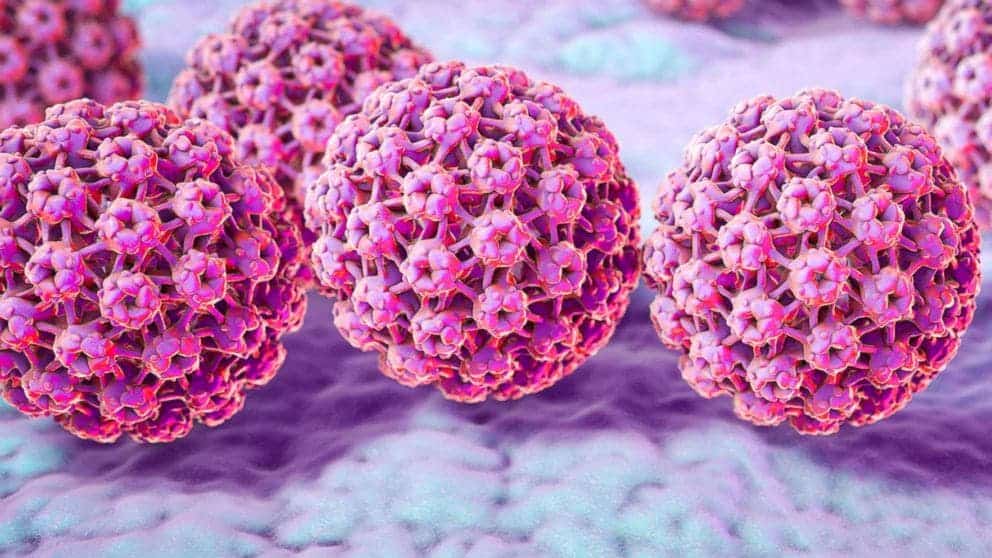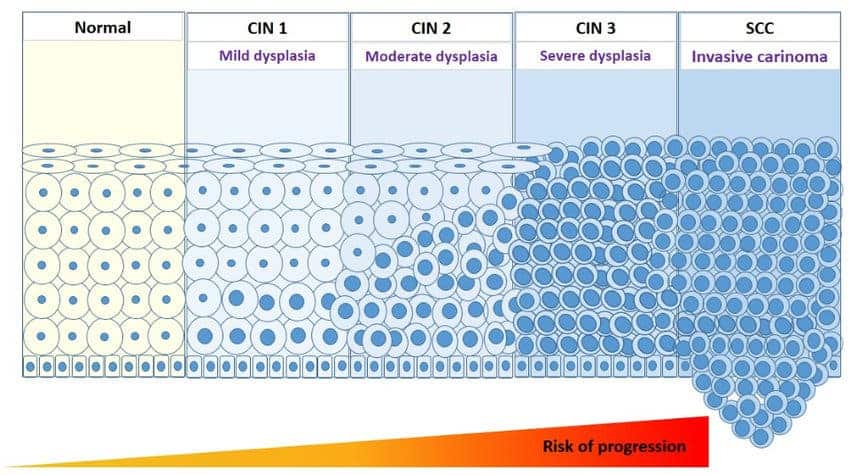The human papillomavirus (HPV) infection has emerged as a major focus for the development of immunotherapeutic vaccines. Persistent infection with the virus causes at least six cancers or cancer precursors, with cervical cancer accounting for 80% of the worldwide burden of HPV-related cancers.
About 30 HPV types are spread through genital contact. Each is “named” with a number, in the order of their discovery. In addition, they are divided into two groups: There are about 12 types of HPV that are called “low risk” because they cannot cause cervical cancer. They can, however, cause genital warts or very minor cell changes on the cervix. These low-risk types of HPV are known by the numbers 6, 11, 40, 42, 43, 44, 53, 54, 61, 72, 73 and 81. Types 6 and 11 – which are linked to about 90 percent of genital warts – are the most common. There are more than a dozen types of “high-risk” HPV that can cause abnormal cells to form on the cervix. These abnormal cell changes may gradually develop into cervical cancer if not removed. The 13 high-risk HPV types are 16, 18, 31, 33, 35, 39, 45, 51, 52, 56, 58, 59 and 68. Types 16 and 18 are the most dangerous, since they cause about 70 percent of cervical cancers.
The therapeutic vaccine injects a specific protein that triggers the immune system to attack high-risk HPV types that cause nearly all cervical cancer precursors, known as cervical intraepithelial neoplasia or CIN. Cervical precancerous lesions are divided into three grades of severity: CIN 1 lesions generally clear up on their own. CIN 2 lesions can resolve on their own, but can also progress to CIN 3 lesions. CIN 3 is the most severe. It’s a slow-growing disease and fewer than half of CIN 3 lesions will develop into cancer in 20 – 30 years. While prophylactic human papillomavirus (HPV) vaccination exists, women are still developing CIN grade 2 or 3.
The new study published in Gynecologic Oncology is a major step forward in efforts to prevent the progression of HPV-positive cervical lesions to cervical cancer and to reduce the treatment burden for the lesions. Women 18 years and older who had confirmed CIN2/3 were enrolled in a randomized, double-blind, placebo-controlled phase II trial and assigned to the vaccine candidate in a 2:1 ratio (vaccine : placebo). Overall, the subcutaneously administered vaccine led to clearance of precancerous cervical lesions was significantly higher in the vaccine group than placebo for CIN 2/3 regardless of the 13 HPV types assayed (24% vs. 10%, p < 0.05). The candidate vaccine also cleared CIN 3 lesions regardless of HPV type (21% vs. 0%, p < 0.01). Subgroup analyses consistently showed clearance rates two to three times higher with the vaccine, irrespective of HPV type or lesion severity. The vaccine was well tolerated with the most common adverse events being injection site reactions.
“Women who are afraid of having any kind of surgery, who haven’t had any children yet, who don’t want to have a surgical procedure, would be very excited about an option of having three shots, getting rid of their disease, and then not having to have surgery,” said Dr. Diane M. Harper, lead author and Professor of Obstetrics and Gynecology, University of Missouri Kansas City.
Surgery, which has a high cure rate, remains the cornerstone of therapy for cervical cancer but is associated with a risk of reproductive morbidity. A clear need exists for nonsurgical, non-ablative therapeutic options to treat HPV-associated diseases, the authors continued. Current screening strategies for HPV-associated diseases do not have any therapeutic option for women with persistent infection, which carries an unknown risk of progressing to cancer.
This study is the largest study to date following women for the longest time frame trialing a therapeutic vaccine for HPV associated CIN 2/3.









